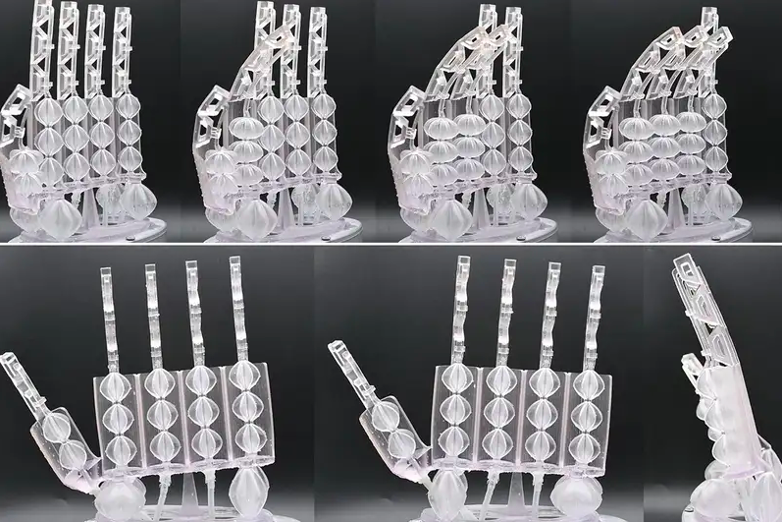Scientists from the Italian Institute of Technology (IIT) have developed a new type of artificial muscle using 3D printing that can better mimic the movements of a human hand and lift 1000 times its weight. This breakthrough opens the doors to the next generation of robotics and takes us one step closer to making a real-life Luke Skywalker prosthetic arm.
Scientists have long been searching for a way to mimic the movement of the human hand, but have yet to create an actuator that can move with the same grace and complexity. Most replicas are either too stiff or not strong enough for practical purposes.
However, Dr. Corrado De Pascali and his colleagues from IIT have recently developed a new form of artificial actuators using a single 3D printed monolithic component. The result is more flexible and stronger than the previous generation of artificial muscles and can move in human-like patterns.

GRACE actuated actuators within a robotic hand mimic human movement. Source (Italian Institute of Technology)
Their new artificial muscles, which they dubbed GeometRy-based Actuators that Contract and Elongate (GRACE), are capable of stretching and contracting like those of a human. The actuators were designed using a mathematical model and 3D printed with a flexible photopolymer resin. Their biggest adaption from previous designs was the addition of pleats into the muscles, which allow them to furl and unfurl, providing greater strength and flexibility compared to other artificial muscles. One eight-gram actuator alone can lift up to eight kilograms.
The group has since explored the artificial muscles’ capabilities further and has combined 18 different-sized actuators to form a robotic hand. Impressively, this device was able to twist its palm, rotate its wrist, and bend its fingers by applying force to different parts of the hand.
Nevertheless, the scientists noted, “it still remains difficult to recreate the ‘versatility and grace of movements’ made possible by the complex arrangements of muscles inside the human body.” However, the actuators are still a vast improvement on previous technologies.
More research will need to be conducted before these artificial muscles see robust implementation, but one area of research of particular interest is resin formulation. There’s a lot of potential for these types of devices and if the resins can improve in strength and flexibility, at which point the range of applications for these artificial muscles can be expanded further.
These new 3D-printed muscles will no doubt sit alongside other improvements in the prosthetic and robotic advancements we have seen recently. While not perfect, we are excited to see where the technology goes from here. Maybe even one day, the technology will progress so far that when we inevitably cut off our hand playing with our lightsabers, this technology may be used to create your personal 3D printed -Luke Skywalker prosthetic.
The full journal article can be found at Science Robotics.
Subscribe to Our Email Newsletter
Stay up-to-date on all the latest news from the 3D printing industry and receive information and offers from third party vendors.
Print Services
Upload your 3D Models and get them printed quickly and efficiently.
You May Also Like
Johns Hopkins University Researchers Develop HyFAM Technology
Two scientists from Johns Hopkins University, Nathan C. Brown and Jochen Mueller, have developed a hybrid manufacturing technology they call HyFam, or Hybrid Formative Additive Manufacturing. Their work on this technology...
3D Printing G-Code Gets an Upgrade: T-Code
Good old G-Code still manages many 3D printers, great and small. Just like the STL, it’s a standard that enables collaboration while also holding the additive manufacturing (AM) industry back....
AM Rewind: The Biggest News and Trends of 2024
After a sluggish 2023, driven by persistent inflation and geopolitical tensions, 2024 has seen some recovery. Economic growth climbed from about 2.8 percent in 2023 to a modest 3.2 percent...
Metal Wire 3D Printer OEM ValCUN Announces Plans for 2025 Expansion
ValCUN, a Belgian original equipment manufacturer (OEM) of wire-based metal additive manufacturing (AM) hardware, has announced that the company has entered the next phase of its growth trajectory, making key...

































